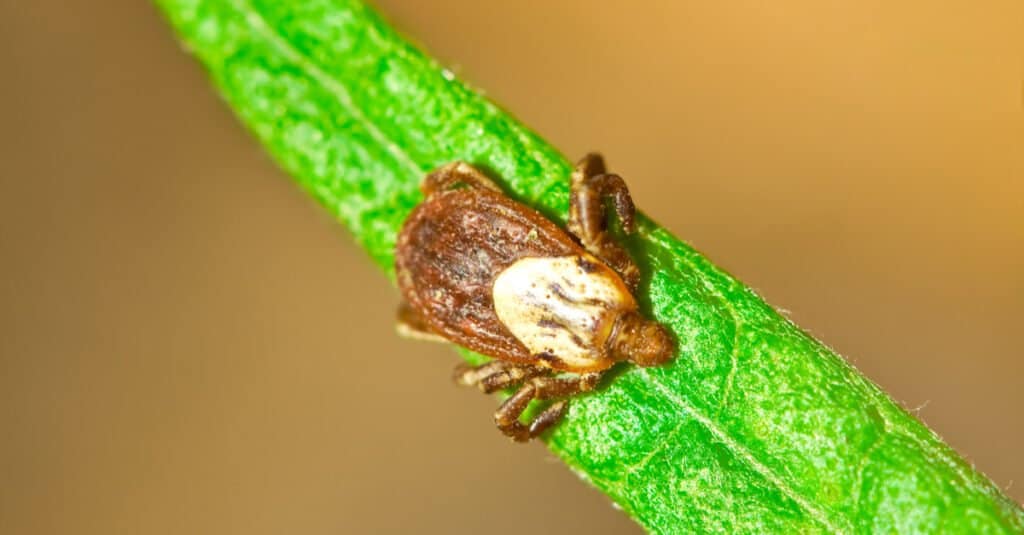Wood Tick
Dermacentor andersoni
Almost always found above 4,000 feet in elevation
Advertisement
Wood Tick Scientific Classification
- Kingdom
- Animalia
- Phylum
- Arthropoda
- Class
- Arachnida
- Order
- Ixodida
- Family
- Ixodidae
- Genus
- Dermacentor
- Scientific Name
- Dermacentor andersoni
Read our Complete Guide to Classification of Animals.
Wood Tick Conservation Status
Wood Tick Facts
- Prey
- Blood
- Name Of Young
- Larvae
- Group Behavior
- Solitary
- Fun Fact
- Almost always found above 4,000 feet in elevation
- Biggest Threat
- Consumption by mites or nematodes
- Most Distinctive Feature
- Gray and brown markings on abdomen
- Other Name(s)
- Rocky Mountain wood tick
- Gestation Period
- 1-30 days
- Litter Size
- 4,000-6,000 days
- Diet
- Omnivore
- Type
- Arachnid
- Common Name
- Wood tick
- Number Of Species
- 1
- Location
- North America
- Group
- Ticks
Wood Tick Physical Characteristics
- Color
- Brown
- Skin Type
- Exoskeleton
- Lifespan
- 2-3 years
- Length
- 2-14 mm
- Age of Sexual Maturity
- 30-400 days
View all of the Wood Tick images!
“The Rocky Mountain wood tick is the primary vector for Colorado tick fever virus.”
Ticks are famous for their ability to spread Lyme disease. Fortunately for dwellers of the high mountain zones along the Rocky Mountains, Rocky Mountain wood ticks aren’t likely to give anyone Lyme disease. They are, however, the main spreader of the Colorado tick fever virus. No matter what kind of tick it is, bites can be traumatic and painful, and may even turn serious.
Like all ticks, wood ticks are closely related to spiders, mites, and scorpions. Ticks have been around since dinosaurs roamed the earth; fossilized ticks date as far back as the Cretaceous era, 100 million years ago. Today, there are over 900 varieties of tick. A handful of those species have experienced a population boom in North America in recent decades. Now, more than ever, it’s important to know your ticks, how to avoid them, and what to do if you find one feeding off you or your pet.
4 Incredible Rocky Mountain Wood Tick Tick Facts!
- Rocky Mountain wood ticks can expand up to six times their normal size when engorged
- Males and females have very different coloring and markings
- Only adults are known to feed on humans
- They can go over a year without feeding
Rocky Mountain Wood Tick Species, Types, and Scientific Name
Scientifically, wood ticks are known as Dermacentor andersoni. They’re closely related to other members of the hard-bodied tick family known as Ixodida, such as American dog ticks, brown dog ticks, and deer ticks. There are only one species of Rocky Mountain wood tick; they’re one of the half a dozen or so problem species of tick in North America.
Appearance: How to Identify Wood Ticks
Like all ticks, wood ticks look very different depending on whether or not they’ve recently ingested a blood meal. Unfed ticks are between 2-6 mm long—that’s smaller than the head of a match, while engorged ticks can reach up to 14 mm long. Young wood ticks in the larval or nymph stages are even smaller, they may be difficult to see with the naked eye, though they can still bite humans and pets.
Wood tick bodies are made up of three main parts: the head, abdomen, and legs. The head is located at the front of the body, it’s short and small compared to the abdomen. Altogether, the head and mouthparts are known as the capitulum. The main components of the mouthparts are the chelicerae (jaws), which are used for cutting into the skin, and the hypostome, a tongue-like organ the tick inserts into the skin as an anchor while feeding.
Wood tick abdomens have a base color of red-brown with beige markings on the back. They look almost identical to American dog ticks. In fact, the only real way to tell the two apart is by where they’re located in North America. Male wood ticks have mottled abdomens covered in markings, while females have a tan scutum—the shield protecting the area just behind their head—and a fully red-brown body.
Like the abdomen, the wood tick’s legs are also red-brown. Each leg has seven segments ending in a claw. Up close, they look very similar to the legs of a scorpion.

©South12th Photography/Shutterstock.com
Life Cycle: How to Identify Rocky Mountain Wood Tick Eggs
Wood ticks are what’s known as a three-host tick. This means that they take a new host for each stage of their life cycle, beginning with larvae. Larvae hatch from egg clusters on the ground, kept safe by leaf litter, tall grass, or shrubs. Females lay up to 6,000 eggs per cluster, so hatching can be a busy time—baby wood ticks emerge in late spring. Being so tiny, they’re limited to small hosts for their first feed, including mice, rats, amphibians, and reptiles.
After a single blood meal, the larvae molt and emerge as nymphs. Where larvae have only six legs, nymphs have all eight of their legs. The nymphs again seek out a host; now that they’re bigger, they can attach to larger creatures, like raccoons, rabbits, dogs, and even humans. To find a host, they crawl to the ends of knee-high grass or shrubs, hold out their front pair of legs, and wait for something to brush by.
Once the nymphs have taken a suitable blood meal, they drop off the host and molt once again. The molting process can take up to two weeks, though each stage of life can be extended by months or even years if there are no meals to be found.
After molting, the nymph emerges as an adult. Adult males usually take a few smaller blood meals from different hosts, moving around in between in search of a mate. Females, on the other hand, often take only a single host, gorging themselves to capacity on blood. Once they’re full, the female drops off converts all that blood into eggs lays her clutch and dies. Wood ticks can live up to three years.
Habitat: Where to Find Rocky Mountain Wood Ticks
Wood ticks are best known by their location; they favor elevations of 4,000 feet and above, though you won’t find them in alpine zones. They’re common throughout the Rocky Mountains, as well as the mountainous zones of the Pacific Northwest. They generally stay away from forests, preferring instead open fields, second-growth forests, or shrubland.
Diet: What do Wood Ticks Eat?
It may come as a surprise, but wood ticks (along with all other species of tick) eat nothing but blood. They get all their nutrients from this single substance. Adults prefer feeding on medium to large vertebrates, like humans, sheep, cattle, dogs, and deer.
What Eats the Rocky Mountain Wood Tick?
As larvae, wood ticks are commonly eaten by mites and nematodes. As they age and grow bigger, other creatures, like toads, frogs, mice, rats, lizards, and birds, snap them up. Opossums are also notorious tick killers; they eat any ticks they find on their bodies as part of their grooming process.
Rocky Mountain Wood Tick vs. American Dog Ticks
Both the wood tick and the American dog tick have red-brown bodies with mottled tan markings. They’re even the same size, and prey on many of the same animals. The biggest tip-off for which species you’re looking at comes from your location. If you’re anywhere outside of the mountainous West in the United States, then you’re probably looking at an American dog tick.
Prevention and Treatment: Wood Tick Bites
Wood ticks aren’t known to transmit Lyme disease, but they can spread the Colorado tick fever virus and Rocky Mountain spotted fever to humans and pets. If you plan on going outdoors during tick season (April through November), take a few precautions to avoid bites.
First, wear long pants, long sleeves, and long socks. When hiking, stay on trails, and don’t walk through any shrubs or tall grasses that brush against you. After your hike, be sure to check yourself and your pet for ticks.
If you do find an embedded tick, don’t wait to pull it out, but don’t touch it with bare skin either. Tweezers or tick removal tools work best for removing ticks. To remove an embedded tick, firmly grasp the body near the head, then gently pull until the tick comes away. Clean the area with alcohol, hand sanitizer, or soap and water. Then, monitor the bite for several days; if a severe rash develops, seek medical advice.
View all 108 animals that start with WThank you for reading! Have some feedback for us? Contact the AZ Animals editorial team.
Sources
- University of Rhode Island / Accessed February 26, 2022


















